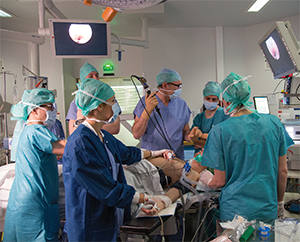
Endoscopic surgery.
© Voisin / Phanie / Science Source
The value of drug-induced sleep endoscopy (DISE) is a topic that continues to be debated in otolaryngology, and experts took sides in a panel session held during the Triological Society Combined Sections Meeting, shedding light on the advantages and disadvantages of the procedure, as well as its efficacy in children with obstructive sleep apnea (OSA).
Explore This Issue
March 2017Detecting Obstruction
Jolie Chang, MD, assistant professor in the department of otolaryngology-head and neck surgery at the University of California San Francisco, said DISE, which involves a three-dimensional assessment of the airway during sedation that’s intended to mimic what happens during sleep, can be an asset in several ways. “It’s especially useful as a procedure for assessing the upper airway to determine surgical planning, candidacy for the hypoglossal nerve implant, and for surgical non-responders,” she said.
In comparisons with in-office awake exams, DISE has been found to be better at detecting more severe obstruction in OSA, particularly at the hypopharynx, and can pick up epiglottis obstruction that might not be seen in patients who are awake (Laryngoscope. 2013;123:2315-2318).
In a 2011 study of patients who had undergone uvolopalatopharyngoplasty (UPPP) but still had persistent sleep apnea, assessment with DISE found that half of these patients still had residual palate obstruction, and almost all had prominent hypopharyngeal obstruction (Laryngoscope. 2011;121:1320-1326). Furthermore, a more recent study found that DISE led to changes in surgical plans in half of cases, compared with plans made after the awake exam (Laryngoscope. 2016;126:768-774).
Cost Versus Outcomes
But David Steward, MD, professor of otolaryngology at the University of Cincinnati, Ohio, said the literature shows that DISE tends to lead to more procedures and more cost, without better results.
In a Level 1, randomized controlled trial, 39 patients selected for primarily palatal surgery by way of preoperative nasal pharyngoscopy were randomized to receive DISE and possibly additional procedures as a result. Both groups saw significant improvement in apnea-hypopnea index (AHI) and Epworth Sleepiness Scale (ESS) scores, but there were no significant differences between the groups. The DISE group was more likely to undergo additional procedures (Laryngoscope. 2015;125:2220-2225). “About 60% of patients had an additional procedure added, based on the sleep endoscopy, with no improvement in their outcomes,” Dr. Steward said.
Dr. Steward acknowledged there were findings that DISE led to changes in surgical plans but noted that there was no association found between outcome and the use of DISE (Laryngoscope. 2016;126:768-774).